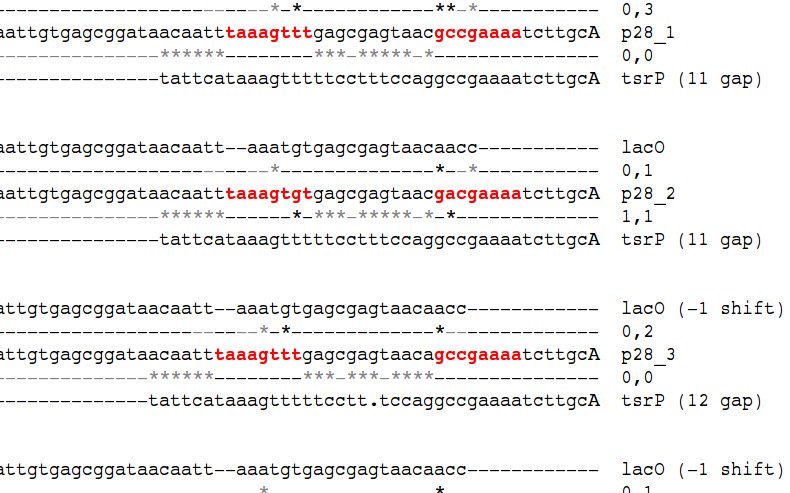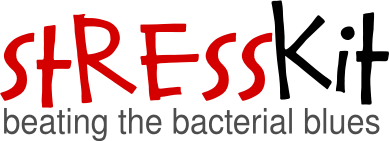From 2008.igem.org
Project Details
StressKit: A BioBrick library of Lac-repressed sigma-24, sigma-28, sigma-32 and sigma-38 promoters for Escherichia coli.
Background
Regulated gene expression is an essential part of the synthetic biologist's toolkit. The Registry of Standard Biological Parts contains a growing number of promoters whose expression can be controlled externally, using chemical signals such as IPTG and arabinose, or physical signals such as light or temperature shifts. In contrast to such specific sensors, bacteria have evolved 'generalized stress response systems' which subtly integrate several sources of information, and when necessary generate genome-wide changes in patterns of gene expression. This is achieved by the activation of 'alternative sigma factors' which displace the 'housekeeping sigma factor' from the RNAP holoenzyme, causing it to activate transcription at specific sigma-dependent promoters. We set out to design, construct, and validate a library of sigma-dependent promoters for Escherichia coli, with the following design specifications:
- Physical specification: The promoters must conform to the BioBrick format, and expression must be quantifiable using an existing BioBrick fluorescent reporter. This ensures that our library can be used immediately in conjunction with Registry parts.
- Functional specification: The promoters must be 'gated' by the LacI repressor, so they remain switched off unless a Lac inducer such as IPTG is present. In the presence of IPTG, the promoter must behave like a 'bare' sigma-factor-dependent promoter, expressing only under specific stress conditions.
- Modularity: The entire library of promoters must have the same design format; each promoter must involve a minimal DNA region, and must not require any transcription factors apart from LacI and the relevant sigma factor; and the promoters must have minimal cross-talk. This ensures that that different sigma-dependent responses can be directly compared, and if necessary combined into the same device, with no additional components required.
|  Design of promoters as a fusion between a lac and sigma dependent promoter |
σ Factors
| Escherichia coli has seven sigma factors, of which we deal with four: sigma-24 mediates the unfolded-protein response; sigma-28 mediates flagellar biosynthesis; sigma-32 mediates the heat-shock response; and sigma-38 is involved in stationary-phase expression. We need not or cannot deal with the remaining three: sigma-70 is the housekeeping factor; sigma-19 mediates the iron-starvation response, but only two of its promoters are known; and sigma-54 mediates the nitrogen-starvation response, but all its promoters require an additional transcriptional activator.
|  Design of promoters as a fusion between a lac and sigma dependent promoter |
Design Logic
| Sigma factors drive transcription by binding to specific nucleotide signatures at the -10 and -35 boxes of their cognate promoters. We started our design process with the LacO promoter of Lutz and Bujard, which contains two LacI binding sites, and sigma-70 boxes. Using published experimental and bioinformatic data, we generated 'hybrid' promoters in which the sigma-70 boxes were partially replaced with alternative sigma boxes, with minimal disruption to the LacI binding sites. In this manner, we designed four hybrid promoters for each alternative sigma factor.
|  Design of promoters as a fusion between a lac and sigma dependent promoter |
Part Construction and Experimental Validation
| We generated the promoter regions along with the BioBrick prefix and suffix by total synthesis, and cloned them upstream of a YFP expression construct (BBa_E0430). To measure YFP expression, we use a spectrophotometer for population-averaged measurements, and a fluorescent microscope for single-cell measurements. We are currently characterizing the library of promoters against a standard control, the unmodified Lutz-Bujard LacO promoter.
|  Design of promoters as a fusion between a lac and sigma dependent promoter |
Protocols
Procedure for growth curve (Before standardisation)
- Inoculate the LB broth with a single colony and grow it as an overnight culture.
- Add 50µg/ml spectinomycin for the flask containing the k12z1 strain and 100µg/ml of ampicillin for all the other flasks containing the constructs
- We transfer X% inoculum such that the cells reach the OD of 0.1 in the M9 minimal media, transfer 1% of the overnight LB culture into the flasks containing the plasmids grown in M9 minimal media.
- Take two sets of are samples (1ml each) from each flask for OD and CFP measurements.
- Samples were taken hour.
- To measure OD we centrifuge the sample for 10 min at 10000 rpm
- Then resuspend them in saline and take the reading using a UV spectrometer @600nm
- Saline was used as blank solution
- For YFP measurements 1 ml of the sample was taken and measurement was done at a 434nm excitation and 470nm emission in fluorescence microscope
.
Growth curve (standardized)
- Inoculate the LB broth with a single colony and grow it for 6hours.
- Add 100µg/ml spectinomycin for the flask containing the k12z1 strain and 50µg/ml of ampicillin for all the other flasks
- Transfer 1% of the overnight LB culture into the flasks containing the plasmids grown on M9
- Take two sets of are samples (1ml each) from each flask for OD and YFP measurements.
- Samples should be taken hour( up to 8 hrs )
- The OD was measured without centrifugation @600nm
- M9 medium was used as blank solution
- The YFP was measured at 514nm excitation and 527nm mission in fluorescence microscope.
Standardized protocol for stress
- Inoculate the LB broth with a single colony and grow it for 6hours.
- Two flasks were assigned for each plasmid. One flask with IPTG (0.25mm) and the other without IPTG.
- Transfer 1% of the overnight LB culture into the flasks containing the plasmids grown on M9
- Allow it to grow for 4hrs
- Then we stress it using the following conditions:
- 500mM NaCl in Minimal Media M9
- 100microM H2O2 in Minimal Media M9
- Heat Shock by keeping in 42 degrees for 120 seconds
- PH of 5.5 achieved by adding 4.150 ml of 3% HCl in 50 ml Minimal M9
- Starvation stress: Pellet out cells in early exponential phase and re suspend them in M9 media without glucose. This is called severe CARBON - LESS stress
- The first sample was taken after 30min of stressing.
- Samples were taken every subsequent hour (up to 5hours)
- The OD was measured at 600nm using UV spectrometer.
- The YFP was measured at 514nm excitation and 527nm emission in fluorescence microscope.
Preparation of M9
- Prepare 10x m9 stock solution
For 50 ml of M9 media
- 10x m9 -5 ml
- 20% glucose - 1ml
- MgSO4 - 0.1 ml
|
 "
"

